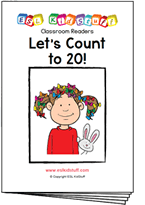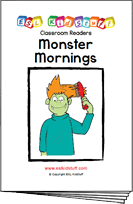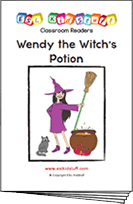Numbers 1-20 lesson plan
Stand-alone lesson ESL kids lesson plan
Lesson plans for ESL kids teachers

Numbers 1-20
In this lesson students learn to count up to 20. Students play numbers and counting games, sing a fast-paced counting song, read a fun story and do a numbers worksheet,
Members get accompanying worksheets, song and classroom reader.
Download materials:
Our lesson plans are FREE!
Sign up for accompanying:
✔ worksheets
✔ homework sheets
✔ craft sheets
✔ flashcards
✔ song downloads & videos
✔ classroom readers & videos
Click to see lesson details, materials and supplies
Time: 40 mins – 1 hour
Objectives: Counting up to 20.
Structures: “How many ~ can you see?”, “Let’s count together”.
Target vocabulary: 1 – 2 – 3 – 4 – 5 – 6 – 7 – 8 – 9 – 10 – 11 – 12 – 13 – 14 – 15 – 16 – 17 – 18 – 19 – 20
Lesson materials
Printables:
- 1-20 balls write 1 worksheet
- 1-20 balls write 2 worksheet
- Reader worksheet
- Numbers 1-20 song poster
Songs:
- The numbers song 1-10
- Numbers 1-20 song
Readers:
- Let’s count to 20!
Additional materials:
- Numbers 1-20 vocab crossword
- Numbers 1-20 vocab word search
- Count to 20! worksheet
Supplies:
- [hide_on_uk]colored[/hide_on_uk][hide_on_us]coloured[/hide_on_us] pencils
- 10 soft balls, cubes or something similar (tape numbers 1-10 onto the objects)
- 10 sheets of A4 paper with one number (11-20) written on each sheet – then wrap sheets around each other to make a parcel (see point 2 below)
- board with marker / chalk
- device to play the song on
This lesson should be taught after the Numbers 1-10 lesson. Once your students can count to 10 this lesson will help them to reach 20!
Lesson procedure:
Warm up and maintenance:
The beginning of your lesson is extremely important: this is where you set the tone of your lesson and get everyone in the right frame of mind for learning English. It is also an opportunity to check homework and review previous lessons.
Click for warm up suggestions for the start of your lessons
These activities can be done in the following order at the start of your lesson:

1. Greetings and name tags
Greet the students by name as they enter the classroom and gesture for them to sit down. Before class prepare some blank name tags (stickers or pin-on tags). Give these out and have everyone write their names and put their tags on. If you use pin-on tags, you can keep and give out every class.

2. Homework check
Check each student’s homework set in the last lesson. Ask each student some questions about their homework worksheet (e.g. “what [hide_on_uk]color[/hide_on_uk][hide_on_us]colour[/hide_on_us] is it?”), give lots of praise, and then put some kind of mark on the homework sheet (e.g. a sticker, a stamp or draw a smiley face). Finally, tell your students to put their homework back into their bags.
3. Review past lessons
Reviewing past lessons is very important – students need constant practice of new vocab, structures, songs, games and so on. Always review parts of your last lesson as well as some parts from other previous lessons. You can spend 5-10 minutes reviewing – it’s fine to recycle games and activities from your past lessons to review as kids enjoy playing familiar games (although be careful not to play a game to death!). See the section “Other ideas to include in your warm” below for ideas.
You can also include review activities in the main body of your lesson. Kids can have short attention spans so it’s good to be able to pull out lots of activities during different stages of the lesson.
Other ideas to include in your warm up:
Ball pass questions
This is good to review questions from previous lessons. Get everybody standing in a circle.
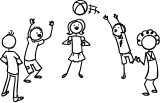
Round 1:
Take a ball and hold it and say, “My name is (you name)”. Then throw the ball to one student and say, “What’s your name?”. Students throw the ball around randomly, saying their names and asking for names.
Round 2:
This time ask a review question, e.g. “How many tables are there?”. Then throw the ball to a student who should answer, “There are (6) tables”. Help if necessary. Then that student throws the ball to another student and asks a “How many …?” question. Continue so everyone has a go. You can have multiple rounds with different topic questions.

Play “Spin the bottle”
Sit students in a circle with a bottle in the middle. Teacher spins the bottle. When it stops spinning the student it is pointing to has to answer a question. If the answer is correct then that student can spin the bottle. This is a good class warm up activity (e.g. How are you? What’s your [hide_on_uk]favorite[/hide_on_uk][hide_on_us]favourite[/hide_on_us] food? How’s the weather today?, etc.

Play “Vocabulary basketball”
This is a fun game which reviews vocabulary from previous lessons. You will need a basket (a trash can) and 2 balls (or 2 pieces of A4 paper scrunched up into balls).
Form 2 teams and line them up so that two players from each team are facing the front with the basket in front of them. Let both players throw their ball – if they get their ball into the basket they can try and win a point by giving the correct answer to a question the teacher asks. This can be an actual question (e.g. What are you wearing?) or a flashcard (What’s this?). Then they go to the back of the line. At the end, the team with the most points is the winner!
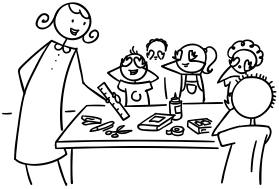
Play “What’s missing?”
This is a fun review memory game – students will have to try to remember review objects from previous lessons (e.g. classroom stationery). Lay the objects out on a table for all to see. Allow the students a minute to memorize the positions of the objects. Remove an object and hold it behind your back. Say, “Open your eyes!” – the first student who can shout out the missing object wins a point for his/her team. Play for all the objects.
Finally, calculate which team has won the most points and give them a round of applause.

Play “Quiz game show”
This is a fun quiz game, like a simple version of a TV game show. Draw some circles on the board and randomly write numbers 1, 2 or 3 in each circle. These will be points.
Put students into teams. Then ask the first team to choose a number – 1 is an easy question (e.g. “Do you like bananas?”) and 3 is a difficult question (e.g. point at a clock and ask, “What time is it?”). 2 will be in between in terms of difficulty. When the question has been answered correctly, erase that number circle. Play until all the number circles are gone – the team with the most points is the winner!
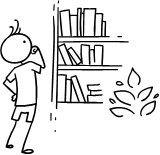
Read a classroom reader again
As you progress through the lessons you will start to build up a catalog of classroom readers (see our Readers download page at https://www.eslkidstuff.com). Kids love going back to old stories and reading through them again. Invite a student to pick a classroom reader and read through it as a class. Make the story as interactive as possible by asking questions (e.g. what [hide_on_uk]colors[/hide_on_uk][hide_on_us]colours[/hide_on_us] there are, the names of different objects, etc.) and getting students to speculate what is going to happen next in the story.

Talk about the weather (do after you have taught the weather lesson plan).
- Prepare a weather board. Before the first class prepare a piece of cardboard and cover it with felt – you are going to pin this to the wall. If you can, try and get blue felt (to represent the sky). Write at the top in large letters, “How’s the weather today?”. Below that write “Today it’s”. Cut out weather pictures (such as our weather flashcards) and stick some velcro on the back. Arrange the weather pictures around the edge of the board and then put the board on the wall of your classroom. You can now use this weather board at the beginning of every lesson.
- Ask about the weather. Ask, “How’s the weather today?” and have students put up their hands. Allow one weather condition per student (e.g. “It’s rainy”) and have each student come up and put a weather picture on the weather board.
- Introduce more weather vocabulary. Depending on weather conditions, you can introduce more weather words (with pictures … you can get students to draw them), such as:
- stormy
- misty
- showery
- freezing
- humid
- frosty
- icy
- drizzly
New learning and practice:
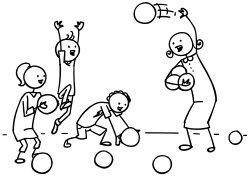
1. Review numbers 1-10
First write the numbers 1-10 on the board and have everyone shout out the numbers as you write them. Next, get 10 soft balls, cubes or something similar (before class, tape numbers 1-10 onto the balls) and chorus the numbers on each ball.
Next throw the balls around the room and ask individual students to bring you different numbers (e.g. “Maria, please give me number 6”).
Finally, play and sing along to “The numbers song 1-10” doing all the energetic actions.
[hide_on_uk]Short sample (members get full-length song):
[/hide_on_uk]
[hide_on_us]Short sample (members get full-length song):
[/hide_on_us]
2. Play “Pass the parcel numbers 11-20”
You are going to play a version of “Pass the parcel” to introduce the numbers 11-20. Before class get 10 sheets of A4 paper and write a number (11-20) on each sheet. Shuffle the papers up so they are ordered randomly. Now make your parcel – roll one sheet of paper onto a ball (with the number on the inside) and then wrap the next sheet (number inside) around the ball. Keep wrapping the sheets around the ball until all are used up and you have a parcel. If you like, you can include a small sweet with each sheet of wrapped paper.
In class, get everybody to sit in a circle.
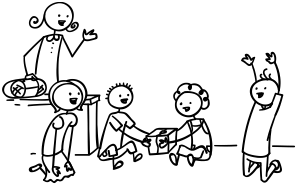
- Play some music and have everybody pass the parcel around the circle until you stop the music. The person holding the parcel when you stop the music can unwrap the first layer. Ask for that sheet of paper and stick it on the board with the number showing. At this point there is no need to teach the number.
- Start the music again and then stop it after the parcel has been passed around a while. The student holding the parcel can unwrap the next sheet and look at the number. S/He should then stick it on the board either to the left or right of the number already there, depending on if it comes before or after that number (e.g. if the first number was 15 and the second one is 19, then it should be placed after the 15).
- Keep playing “Pass the parcel” until all the numbers are stuck on the board in the correct order 11-20.
3. Teach numbers 11-20
Now that you have all the numbers on the board, you can chorus them with your class. Start with 11 and chorus it 3 times with the class. Continue with all the numbers. Now chorus each number in turn (11, 12, 13, etc.) and run through 11-20 a few times, each time getting faster and faster. Now, put your class into pairs. Have each pair practice saying the numbers together (e.g. A: 11, B: 12, A: 13, B: 14, etc.).
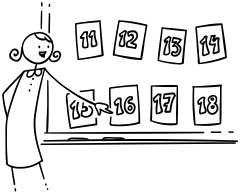
4. Play “Stand in the right order”
Next, give each student a number sheet from the board. If you have more than 10 students make more numbers so you have two groups. For less than 10 students, give out more sheets per student but make sure the numbers they have are in sequence (e.g. give a student numbers 14 and 15, not 14 and 18).
Now tell your students to stand in a line in the right order. Everyone has to shuffle around until they are standing and holding their numbers in order 11-20. Finally, get the class to shout out their numbers from 11-20, down the line. Make it a game – each round try and do it faster than the last!
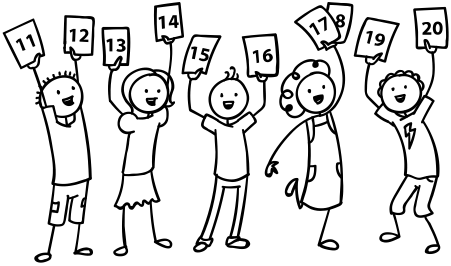

5. Do the “Write the numbers 1-20 on the board” activity
You are going to get everyone to help write the numbers on the board which you can use when singing the “Numbers 1-20 song”. Draw 20 large squares on the board 4 rows. Call out a student and ask him/her to write a large number 1 in the first box. Keep calling out students to fill in the rest of the squares so you have all of the numbers 1-20 on the board.
At the end, it should look like this:
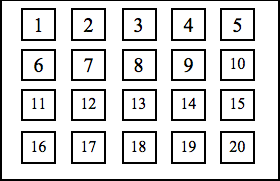
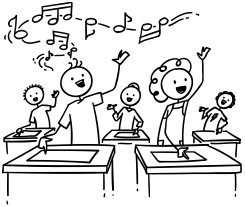
6. Sing the “Numbers 1-20 song”
Play the song and have everybody call out the numbers along with the song. It will help a lot if you point to each number on the board as it is sung. It is a really fast paced song so keeping up might be a challenge but this makes it fun.
Play the song a few times until everyone can sing along well. It is also worth giving everybody a copy of the Numbers 1-20 song poster. As the song is being played the students must sing along and touch each number as it is sung.
Lyrics for the “Numbers 1-20 song”
Verse 1:
1 – 2 – 3 – 4 – 5
6 – 7 – 8 – 9 – 10
1 – 2 – 3 – 4 – 5 – 6 – 7 – 8 – 9 – 10
Verse 2:
11 – 12 – 13 – 14 – 15
16 – 17 – 18 – 19 – 20
11 – 12 – 13 – 14 – 15 – 16 – 17 – 18 – 19 – 20
Verse 3:
1 – 2 – 3 – 4 – 5 – 6 – 7 – 8 – 9 – 10
11 – 12 – 13 – 14 – 15 – 16 – 17 – 18 – 19 – 20
Ok … Let’s do all the numbers!
1 – 2 – 3 – 4 – 5 – 6 – 7 – 8 – 9 – 10
11 – 12 – 13 – 14 – 15 – 16 – 17 – 18 – 19 – 20
Gestures for the “Numbers 1-20 song”
There are a few activities you can do with this song:
- Before playing the song write the numbers 1-20 on the board. Keep them large and in order. Everyone sings along as the teacher points to each number.
- Have the numbers 1-20 printed on A4 sheets of paper and stuck around the walls of the classroom. As the song is sung, everybody has to point to the correct number (the numbers can be put on the walls in the correct order or for a more difficult activity, in random order!).
- Giving everybody a copy of the Numbers 1-20 song poster. As the song is being played the students must sing along and touch each number as it is sung.
[hide_on_uk]Short sample (members get full-length song):
[/hide_on_uk]
[hide_on_us]Short sample (members get full-length song):
[/hide_on_us]
7. Read classroom reader “Let’s count to 20!”
This reader allows your students to practice the numbers 11-20 by counting the objects on each page. Before class, download and print off the reader “Let’s count to 20!”. As you go through each page, get everybody to count along with you, for example:
Teacher: (on page 2) Look, what are these?
Students: Pencils!
Teacher: Yes, well done! … (reading) … “Let’s look in my pencil case. How many pencils can you see?” … Ok, let’s count together!
Students: 1 .. 2 .. etc. .. 17 .. 18!
Teacher: 18? Ok, let’s check … (turns to page 3, reading) … “18! Yes, that’s right!”
Continue through the story, counting out the objects and eliciting / teaching the objects vocabulary. Get the students really involved in the story by asking lots of questions (e.g. about the [hide_on_uk]colors[/hide_on_uk][hide_on_us]colours[/hide_on_us] and the different animals). At the end of the story there is a fun, surprise question about all of the character’s pets which requires going back through the book to count all the animals.

After reading the story, give out a reader worksheet to each student and read through the story one more time (without stopping for questions, etc.) as students write the numbers of the objects in the boxes. Then go through the answers as a class.
Alternatively, watch our video version of the reader (Internet connection required).
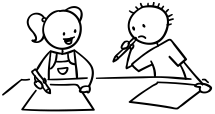
8. Do the “1-20 balls write 1” worksheet
Finish with some quiet time doing a numbers worksheet – use the “1-20 balls write 1″ worksheet. As the students are writing the numbers, walk around, monitor and offer lots of encouragement. Ask everyone questions (e.g. What number is this?”) and encourage each student to say the number as they are tracing it.
Wrap up:
Assign homework: “1-20 balls write 2” worksheet
Click for wrap up suggestions for the end of your lessons

1. Assign homework
Each week give out a homework worksheet for your students to take home. Hold up the homework worksheet and model how to do it. Give out the worksheets and say, “Put your homework in your bags”.

2. Do “Quick check”
Time to leave the class. Make sure everything is put away and the students have gathered their belongings. Have them line up at the door and place yourself between the door and the students. For each student check one new word or phrase, for example:
- hold up an object or flashcard (such as an item of clothing) and ask, “What’s this?”
- ask a question from the lesson (e.g. “Where do you live?”, “Do you like bananas?”, “Can you play chess?”, etc.)
When they give you the correct answer say goodbye and let them leave. If their answer is wrong, have them go back to the end of the line – they will have to try again once they reach the front!
Other lesson plans
Actions, verbs & tenses:
- Can – for ability
- Morning routines
- Daily routines & times of the day
- Actions – Present continuous
- Future plans using “going to”
- Past tense activities – Regular verbs
- Past tense activities – Irregular verbs: Part 1
- Past tense activities – Irregular verbs: Part 2
Adjectives:
- Describing people
- Describing things
- Comparing things (Comparative adjectives)
- Comparing things (Superlative adjectives)
Adverbs:
Alphabet:
Animals:
Body:
Classroom:
Clothes:
Colors:
Colours:
Directions:
Family:
Feelings & emotions:
Food:
Health & sickness:
Holidays & festivals:
Jobs:
Likes, dislikes & favorites:
Likes, dislikes & favourites:
- Likes & dislikes
- [hide_on_uk]Favorites[/hide_on_uk][hide_on_us]Favourites[/hide_on_us] and asking why
Nature & Our world:
Numbers:
Places & where we live:
Prepositions of location:
Pronouns:
Shapes:
Shopping:
Sports:
Time, days, months, seasons:
Toys:
Transport & travel:
Weather:


